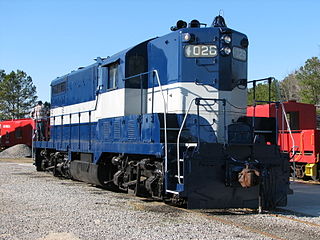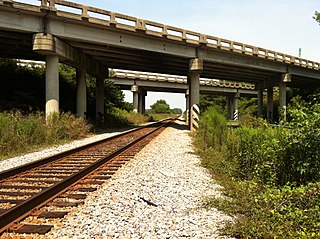
The Georgia Railroad and Banking Company also seen as "GARR", was a historic railroad and banking company that operated in the U.S. state of Georgia. In 1967 it reported 833 million revenue-ton-miles of freight and 3 million passenger-miles; at the end of the year it operated 331 miles (533 km) of road and 510 miles (820 km) of track.
The Wilmington and Weldon Railroad (W&W) name began use in 1855, having been originally chartered as the Wilmington and Raleigh Railroad in 1834. When it opened in 1840, the line was the longest railroad in the world with 161.5 miles (259.9 km) of track. It was constructed in 4 ft 8 in gauge. At its terminus in Weldon, North Carolina, it connected with the Seaboard and Roanoke Railroad and the Petersburg Railroad. The railroad also gave rise to the city of Goldsboro, North Carolina, the midpoint of the W&W RR and the railroad intersection with the North Carolina Railroad.
The Raleigh and Gaston Railroad was a Raleigh, North Carolina, based railroad opened in April 1840 between Raleigh and the town of Gaston, North Carolina, on the Roanoke River. It was North Carolina's second railroad. The length was 100 miles (160 km) and built with 4 ft 8 in gauge. Part of the Raleigh and Gaston's tracks remains in service today as part of CSX's S Line as the Norlina Subdivision of CSX's Florence Division.
The Northeastern Railroad was a 103-mile (166 km) 5 ft gauge railroad that served South Carolina in the second half of the 19th century.

The Conway Seashore Railroad was a South Carolina, US, railroad that operated in the early 20th century. It ran from Conway southeast to Myrtle Beach.
The Columbia and Sumter Railroad was a railroad in South Carolina running between those two cities that began operating immediately after the American Civil War. It later became part of the Atlantic Coast Line Railroad network. The railroad is still in service today and it is now operated by CSX Transportation as their Eastover Subdivision.
The Georgetown and Western Railroad was a Southeastern railroad that served South Carolina in the late 19th century and early 20th century. At its greatest extent, it ran from Lane, South Carolina east to the port city of Georgetown.
The Central Railroad of South Carolina was a South Carolina railroad that operated following Reconstruction. It ran between the town of Lane and Sumter, a distance of about 40 miles (64 km). The line is in service today as CSX's Lane Subdivision.
The Wilmington, Chadbourn and Conway Railroad was a Southeastern railroad that operated between Chadbourn, North Carolina and Conway, South Carolina near the end of the 19th century.
The South Carolina Western Railway was a Southeastern railroad that operated in the early 20th century.
The Monroe Subdivision is a railroad line owned by CSX Transportation in the U.S. states of North Carolina and South Carolina. The line runs from Pee Dee, North Carolina to Abbeville, South Carolina, for a total of 177 miles. The full line is dispatched by Centralized traffic control.
The Portsmouth Subdivision is a railroad line owned by CSX Transportation in Virginia and North Carolina. The line connects CSX's network with the port city of Portsmouth, Virginia. The Portsmouth Subdivision was historically operated by the Seaboard Air Line Railroad, a CSX predecessor.

The South End Subdivision is a railroad line owned by CSX Transportation in the U.S. states of North Carolina and South Carolina. The line runs from Rocky Mount, North Carolina, to Florence, South Carolina, for a total of 172.8 miles (278.1 km). At its north end the line continues south from the North End Subdivision and at its south end the line continues south as the Charleston Subdivision. The South End Subdivision is a part of CSX's A Line, one of their mainline which ultimately extends from Richmond, Virginia to Tampa, Florida.
The Fayetteville Cutoff was a railroad line in North Carolina and South Carolina built by predecessors of the Atlantic Coast Line Railroad connecting Wilson, North Carolina with Pee Dee, South Carolina. Its main purpose was to shorten the Atlantic Coast Line's main line.

The Atlantic Coast Line Railroad’s Main Line was the backbone of the Atlantic Coast Line Railroad's network in the southeastern United States. The main line ran from Richmond, Virginia to Port Tampa just southwest of Tampa, Florida, a distance of nearly 900 miles. Along its route it passed through Petersburg, Rocky Mount, Florence, Charleston, Savannah, Jacksonville, and Orlando. With the exception of a short 61-mile segment in Greater Orlando, the entire line is still owned by the Atlantic Coast Line's successor, CSX Transportation, and is still in service as their A Line.

The Carolina Central Railroad, was a railway company in the United States. It was incorporated in 1855 as the Wilmington and Charlotte Railroad and was renamed the Wilmington, Charlotte and Rutherford Railroad shortly after. It was reorganized as the Carolina Central Railway in 1873. It built 152 miles (245 km) of track, in two unconnected sections, in the southern part of North Carolina. The company was again reorganized as the Carolina Central Railroad in 1880. In 1900, the Carolina Central Railroad was merged into the Seaboard Air Line Railroad. Its lines are now owned by CSX Transportation.
The Seaboard Air Line Railroad's East Carolina Line was the unofficial name of their line running from Hamlet, North Carolina through eastern South Carolina to Savannah, Georgia. Officially designated on Seaboard employee timetables as the Andrews Subdivision from Hamlet to Andrews, South Carolina, and the Charleston Subdivision from Andrews south, the line was known as the East Carolina Line by Seaboard employees due to its location in eastern South Carolina. With connections to the Seaboard's main line at both ends, the East Carolina Line was frequently used as an alternative freight route for the company.
The Atlantic Coast Line Railroad's Florence—Robbins Line was one of the company's secondary main lines that ran from Florence, South Carolina to Robbins. It was built in the late 1800s and large parts of it were built by the Atlantic Coast Line's predecessor companies. Parts of the line are still in service.
The Atlantic Coast Line Railroad's Wilmington—Pee Dee Line was a railroad line running from Wilmington, North Carolina west to Pee Dee, South Carolina. Running in an east–west trajectory, it notably passed through Lake Waccamaw, Chadbourn, Nichols, and Mullins. Some of the line is still operating today.
The Atlantic Coast Line Railroad's Parkton—Sumter Line was one of the company's secondary main lines running between Parkton, North Carolina and Sumter, South Carolina.





